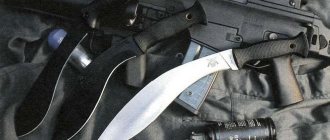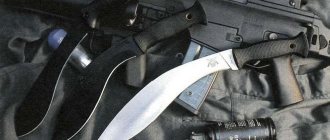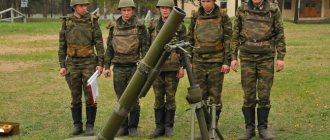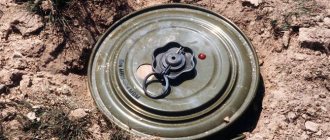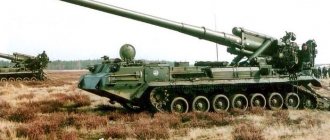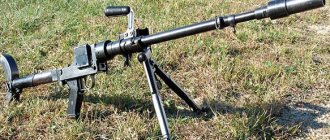Modern means of mining in the service of the armies of the world
It is known that without a good knowledge of military engineering it is impossible to achieve success in combined arms combat. An important component of military engineering is demolition work, which includes various mining systems and means, as well as mine-explosive barriers.
According to experts, mine weapons can be used not only in defense, but also in the offensive, since modern mining means require their high-speed installation, which makes it possible to create minefields directly during the battle.
Portable mining kit "Veter-M", PKM-1
known since the times of the Soviet army. It is the simplest combined arms weapon with which you can remotely install anti-tank and anti-personnel mines. The peculiarity of the kit is that it can be installed not only in advance, but also directly during the battle, which significantly increases the capabilities of tactical defense of troops.
The kit includes a primitive launcher for the PM-4 demolition machine, two cable reels of 50 meters each and a carrying bag. The entire set weighs about 2.5 kilograms. The machine is made in the form of a small metal sheet, to which a tray with an electrical contact is attached at an angle of 45 degrees. The machine places cassettes containing anti-personnel or anti-tank mines and then uses them to fire those cassettes. The machine operates extremely simply - when cassettes are connected to the machine, the contacts between them are closed. Then the blasting machine delivers an electric pulse, igniting the expelling powder charge in the cassette. This makes it possible to throw a mine approximately 30-35 meters. Regardless of the type of mine, the dimensions of the cassette remain the same, only the markings on them change. Thus, there are KSF-1 cassettes with 72 PFM-1 anti-personnel mines, KSF-1S-0.5 cassettes with 36 PFM-1 anti-personnel mines and the same number of PFM-1S, KSF-1S cassettes with 64 PFM-1S anti-personnel mines, KSO cassettes -1 with 8 POM-1 anti-personnel mines, KPOM-2 cassettes with 4 POM-2 anti-personnel mines, as well as KPTM-3 cassettes with 1 PTM-3 anti-tank mine and KPTM-1 cassettes with 3 PTM-1 anti-tank mines.
Mines ejected from cassettes are scattered and form a dispersion ellipse. Its dimensions are about 8-10 meters wide and 18-20 meters long. The probability of damage, depending on the type of mine, ranges from 0.5 to 7 meters. Anti-tank mines are thrown approximately 100 meters. It is possible to install single- and multi-lane minefields.
This remote mining system is valuable for its simplicity, the ability to mine without leaving the trench, laying minefields unexpectedly for a possible enemy and detonating them at the right time.
Another mine device that came from Soviet times is the UMZ universal minelayer
. This is one of the remote mining systems designed for the installation of anti-personnel, anti-tank and mixed minefields. In this case, mines can only be installed on the ground surface.
The minelayer is installed on the chassis of an on-board vehicle Zil-131V. Cassette units in the amount of 6 units are installed in the body on a rotating device, and the emission control system is installed in the cab.
Cassette blocks are independent of each other and can be rotated 360 degrees at different angles.
Depending on the mining scheme, the rotation of the cassettes and their angle of inclination are selected. All this is done manually before mining begins.
Each block can accommodate up to 30 cassettes. And the full configuration of the minelayer is 80 cassettes. Based on the above, the minelayer can be simultaneously loaded with 180 PTM-3 anti-tank mines, 540 PTM-1 anti-tank mines, about 12 thousand PFM-1 anti-personnel mines, 1,440 POM-1 anti-personnel mines and 720 POM-2 anti-personnel mines.
You can also use mixed charging of cassette units. Then, in one pass, the minelayer can carry anti-personnel and anti-tank mines or mines of the same type, but of different variants. You can set up a field in several passes, and also replenish your ammunition at any necessary time.
During mining, the minelayer can reach speeds from 5 to 40 kilometers per hour. Repeated reloading can be completed by 2 people in approximately 1.5-2.5 hours, and a sapper squad of 6 people - in 1 hour.
This minelayer is no different in appearance from a regular ZIL, so the enemy will not be able to identify it. The vehicle's crew will include two people - a driver and an operator.
A more modern means of mining is the VSM-1 helicopter mining system
. It is used to lay anti-tank, anti-personnel and anti-landing minefields using Mi-8MT and Mi-8T helicopters. Most often, this system is used to quickly install minefields in places where the enemy has broken through, as well as in areas where he advances deeper into a protected area. VSM-1 is produced by the Kazan Helicopter Production Association, and the system was developed at the State Research Engineering Institute of the city of Balashikha.
In addition to the mining control panel, the system includes 4 containers for mines, a trolley for transportation, a remote control and a container lifting system. Each container has space for 29 KSO-1 cassettes.
The construction of a minefield is carried out while flying over the area that needs to be mined.
This system is most effective for mining mountainous areas. It was used in Afghanistan as a preventive measure against the Mujahideen. The rate of mine dispersal is about 8.5 thousand mines per minute over an area about 25 meters wide and 2 kilometers long.
Another effective mine weapon is the KMGU universal small-sized cargo container
, which is designed for transporting and dropping front-line container blocks with fragmentation, high-explosive, cumulative and incendiary ammunition. The cassettes, after being dropped, open up, thus ensuring the movement of ammunition along the trajectory of hitting targets. Externally, the container looks like an aluminum power housing with a streamlined shape and two compartments for placing cassette blocks. In the lower part of the body there are flaps that operate from a pneumatic drive. It, in turn, operates from a compressed air cylinder. The carriers of the container are the Mi-28N helicopter and Su-17, Su-27, Su-24, MiG-29 and MiG-27 aircraft.
Remote mining device for the Smerch RZSO with a 9M55K4 rocket
- This is a mining device intended for constructing minefields using PTM-3 anti-tank mines. Mines are placed in cluster blocks of five mines on each of five tiers.
The head of the projectile is separated, and the mines are pushed out using a squib. At the same time, they are put on combat readiness, and after 90-100 seconds the mines touch the ground surface. The dispersion ellipse depends on the trajectory and flight range and is approximately 2 by 2 kilometers.
To obtain such a minefield, 12 charges are needed, that is, one full salvo of “Smerch”. The projectiles are scattered over approximately 150 meters as a result of constant adjustment of their movement using gas-dynamic rudders, as well as rotation around their axis.
The mines remain in combat readiness for a day, after which they self-destruct. If the mines are out of order or are not in a state of combat readiness due to incorrect position, they will also self-destruct within 24 hours. And if they find themselves in close proximity to cars or tanks on metal structures, then the explosion occurs instantly.
The safest distance for people after the mines begin to self-destruct is about 300 meters from the outermost mine. Also, mines of the PTM-3 type can be destroyed using EMT trawls.
The 9M55K4 rocket is used in the Smerch 9K58 multiple launch rocket system, which was adopted by Soviet troops in 1987. Currently, other types of projectiles are used for this installation.
The projectile itself is modular and differs only in warheads: high-explosive fragmentation, cumulative fragmentation, volumetric detonating, incendiary, and also with the use of homing anti-tank combat elements.
The Smerch system is capable of speeds of up to 60 kilometers per hour. The launcher includes 12 pipe guides. A full salvo is carried out in 20 seconds, the destruction range is from 20 to 70 kilometers. The installation is recharged using a 9T234-2 transport-charging machine in 10-15 minutes.
The complete set of the Smerch installation includes the 9A52-2 launcher, the 9T234-2 transport-loading vehicle and the KAMAZ-4310 vehicle with the Vivarium fire control system, which is used for six installations.
Experts are confident that modern mining equipment has become more effective due to the use of electronic fuses and the ability to program mines to self-destruct after a certain time, increased mechanical strength due to the use of durable materials that make it possible to drop them from great heights without damage, an increase in the number of remote mining systems used not only military engineers, but also other branches of the military.
NATO remote mining systems
The command of the armies of the North Atlantic Alliance, which for a long time considered mines as a passive means of introducing hostilities, has a new appreciation for their increased potential. The term “mine ground warfare” is becoming increasingly popular every day.
Minelayers, which are in service with NATO troops, are designed to lay anti-tank mines. They are divided into two groups: self-propelled and trailed. The majority are trailed mine barriers. The distance between mines can be adjusted, so the density of the minefield can be increased or decreased. Most mines are anti-tank anti-bottom mines that hit armored targets over the entire area. Anti-track mines are also used to make it difficult for the enemy to overcome an established minefield.
The FFV 5821 minelayer is located in the MiWS ground mining system. This is a towed device, for towing which a standard vehicle with 720 mines is used. At a speed of 7 kilometers per hour, the minelayer can lay up to 20 mines per minute. The device was developed by a Swedish company. Its deliveries began in 1989 to Germany, and later to the Netherlands.
The British Army Trailed Mine Layer is a standard device used by the Army Corps of Engineers to deploy L9A1 anti-track anti-tank mines. Currently, this type of mine is equipped with a new fuse that is triggered under the entire target area. To tow it, the FV 432 Troujen tracked armored personnel carrier with 144 mines is used. To install mines on the ground surface, they also use the FV 602 Stolvet, which can transport up to 500 mines.
The Spanish trailed mine layer ST-AT/V is used for installing anti-tank, anti-bottom and anti-track mines. An armored personnel carrier with 200 mines is used for towing. The minelayer operates at a speed of 4 kilometers per hour.
The French minelayer F1 has a wheelbase. Its main feature is that when installing mines, it opens an individual hole for each of them, without damaging the plant layer. The hydromechanical organ lifts the turf, and after installing the mine, lowers it back and levels the surface with a roller. The minelayer is designed to install mines of the same size, for example, such as anti-track ASRM.
In the cargo compartment of the installation there are cassettes of 112 minutes each in the amount of 4 units. When installing each mine, the machine stops, and all actions are automated. The mining speed is about 400 minutes per hour.
Remote mining systems are new means that make it possible to install minefields in the shortest possible time at distances from several meters to hundreds of kilometers. The structure of the systems includes mines of various types - anti-tank, anti-personnel, anti-vehicle, the means for their installation and the carrier itself, which can be used as ground vehicles, artillery shells or missiles, as well as airplanes and helicopters.
Ground mining systems are machines that, while moving, are capable of shooting or throwing mines at a distance of 30-100 meters, thus forming a mine strip of several tens of meters. Mines that have fallen to the surface are brought into firing position and are triggered either in the process of impacting the target, or when trying to move them, or in the process of self-destruction. Systems of this type include the American mining systems GEMSS, Vulcan, the German MiWS, the Italian Istrice, and the British Ranger.
Artillery systems are mining weapons that use standard artillery pieces to fire cluster charges containing mines. After falling to the surface, they are brought into a firing position and are triggered during the impact of the armored target or after the expiration date. These include the American RAAMS and ADAM systems.
Missile mining systems use standard MLRS for laying minefields. Despite the fact that many states are engaged in such developments, they are in service only in Germany. They use the Lars-2 system - a 36-barreled launcher. The combat cassette part opens at a given point, and the mines are lowered by parachute under the influence of the air flow. After landing, the parachute is detached and the mine is put on alert.
According to NATO experts, it is advisable to use helicopter systems to set up barriers on enemy routes pursuing retreating troops, to cover the flanks, and also to strengthen already installed barriers. The disadvantage of such systems is that helicopters operate at extremely low altitudes, which significantly increases their vulnerability. Most often, two main types of such systems are used - universal ones, which are mounted on board vehicles, as well as those installations that are transported on the external sling of a helicopter. Among helicopter systems, we can note the American Vulcan system, the Italian DATS, SY-AT, which is used in Spain and Portugal.
Along with equipping NATO troops with these mining weapons, it is also planned to develop new types of such weapons, the effectiveness of which is tested during exercises.
Representatives of the military department identify several main directions along which the development of new minefield systems should develop. This is the development of anti-tank mines capable of hitting a target at a distance of up to 100 meters, the creation of anti-helicopter mines that can hit air targets at low altitudes, as well as sabotage mines for special forces units.
The solution to all these problems is planned in the next decade.
Main types
A mine is an explosive placed in a metal casing, combined with a fuse and a drive device that ensures the detonation of the ammunition. Anti-tank mines (TM and TMK series) are used to destroy enemy tanks and other armored vehicles. Anti-personnel mines are designed to destroy enemy ground forces (MON-50, 90, 100, 200, PMN, POMZ series).
Anti-landing mines (PDM and YARM series) and other special projectiles are also used. Their variety is great: from banal traps and tripwires to magnetic, directional, under-ice and other specifically designed charges.
Requirements for minefields
Properly laid minefields must meet the following requirements:
- It should be as difficult as possible for the enemy to detect a mine and make a passage through the minefield. This can be achieved through high camouflage and a variety of mining schemes, the formation of false minefields and the installation of booby traps.
- Have high efficiency of application, characterized by causing maximum damage to the enemy.
- Ensure resistance from external factors (explosions from neighboring charges, mine clearance charges), which is achieved through the use of explosion-resistant mines and the correct installation scheme.
- It must be possible to quickly detect and clear minefields by its military units. To do this, when installing mines, they are carefully fixed.
Laying minefields with minelayers
When mining anti-tank minefields using minelayers, charges can be placed both on the ground and in a small hole. The crew of the minelayer PMZ-4 includes five people, and its main task is the installation of anti-tank minefields.
The crew operator, number one, is located directly on the minelayer and determines the mining step, monitors the movement of charges on the conveyor belt and controls the plow. Three people remove mines from a container in the back of a car and place them on a conveyor belt. The fifth person is the driver of the tractor. The mining step in this way varies from 4 to 5.5 meters.
The installation of anti-personnel minefields is carried out by PMZ-4 minelayers; a prerequisite for this must be equipment with special trays, and either high-explosive or fragmentation charges are used as mines.
Manual installation
With the manual mining method, charges can be placed either on the ground or buried in the ground to a depth not exceeding 10 centimeters, which allows for additional camouflage.
The process of installing shells is as follows: a depression is dug in the ground no larger than the charge itself, into which it is placed. The handle of the fuse mechanism should be switched from the transport position to the combat position. Then, having removed the pin and the cover of the remote mechanism, pull out its thread to a distance of approximately 1 meter.
Mina is carefully camouflaged. The mining site must be left holding the cover of the remote mechanism in your hands, pulling the thread to its full length, which is about five meters. After 20 seconds have passed since the thread was pulled, the mine goes into a state of combat readiness.
The installation of minefields manually is carried out strictly according to regulations. The sapper platoon, which mines obstacles, consists of three sections, two of which directly lay mines, and the third carries pre-prepared charges to the starting position.
Main characteristics
The main characteristics when constructing minefields are:
- density (characterizes the frequency of laying mines);
- depth (may vary depending on the type of mines installed);
- length of the installation (depends on the specific situation on the front line and the course of hostilities in general).
The density and depth of mine installation also have a direct dependence on the purpose of the minefield, the characteristics of the terrain (flat or rugged, dry or swampy), and the general situation on the line of contact.
When mining, it is important that when a shell explodes, friendly troops are not damaged by shrapnel or a shock wave, and for this, the distance to the troops’ positions must be at least 50-70 meters. The density of installation of charges for an anti-tank barrier should be from 600 to 1000 mines per 1 kilometer of the front line.

